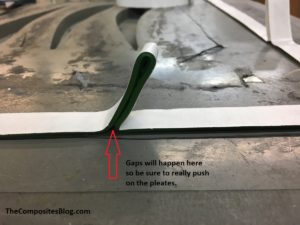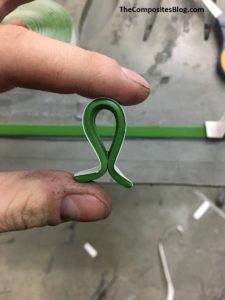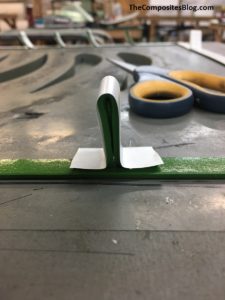There are two techniques I use for making pleats with the gum tape. You can never have to many pleats and to large of a bag to make parts. You can definitely have to small of a bag and it can bridge corners or break open if it stretches to much leaving dry spots on the part. The first method I use 99% of the time is making the pleats as I lay the gum tape across the flange of the part. This is a much quicker and cleaner method. The only downside is you really have to push down on the bottom of the pleat as they are prone to having air leaks as pointed to in the picture. 9 out of 10 times a leak will come from under a pleat. If you use a chemical release, be sure to not release where the gum tape will lay down. The release agent will allow the gum tape to pull up and cause leaks much easier.  The second method is slightly less prone to leaks, but is much more time consuming to add the pleats, and even adds time to applying the vacuum bag due to having to pull each and every bit of backing paper off each pleat. Start by laying out a perimeter of gum tape. Then make “omegas” and squeeze them down where ever necessary on top of your gum tape. The only time I do this technique is if I forget a pleat somewhere, or I end up having excess bag and need to add one to take up the extra material.
The second method is slightly less prone to leaks, but is much more time consuming to add the pleats, and even adds time to applying the vacuum bag due to having to pull each and every bit of backing paper off each pleat. Start by laying out a perimeter of gum tape. Then make “omegas” and squeeze them down where ever necessary on top of your gum tape. The only time I do this technique is if I forget a pleat somewhere, or I end up having excess bag and need to add one to take up the extra material.

 Hope this helps and thanks for reading!
Hope this helps and thanks for reading!
4 thoughts on “Tech Tip- Making Pleats”
Comments are closed.
High there,
I know 2 other methods for make pleats:
1) Fist of, tacky tape all of the outer edge on the surface of your mold – as you mentioned: not coated with release agent on the edge, or even better: remove the release agent before applying tacky tape – (just flat, no pleats incorporated)
Put the vacuum bag on top of the part and try to imagine where you want your pleats and how big you want them (typically on a vertical edge on the part) This allows you to make sure the vacuum bag is big enough. Only then peal away the covering plastic from the tacky tape on the corners (max 10cm) and fix the corners of the bag in place (make sure the bag is positioned correctly: a small angular error on the corner can be a huge pain to correct afterwards.
Start working your way inwards, peeling away only mere centimeters.
Stop +- 10cm (4 inch) before you reach the location in your intended pleat. Repeat from the other side.
You should now have +- 20cm (8 inch) of uncovered tacky tape (all be it easier to leave the covering plastic on top of it) and a bag, big enough to make a pleat.
Take a stretch of tacky tape, 10cm (4 inch) longer than the height of the intended pleat and start working your way up, starting from on top of the tacky tape, onto the vacuum back on the inside of the pleat. (make sure to follow the edge evenly, don’t veer of too much to the inside or outside)
When this last stretch of tacky tape is applied , it should go up, reach the top of the pleat and come down a few centimeters. Now apply the other side of the tacky tape to the remaining vacuum bag, again starting from the bottom, working your way op.
This should result in a fold-over of tacky tape in the top notch of the pleat, but on most parts only 1 layer of tacky tape is applied resulting in fewer waste. It comes in especially useful when working with large pleats (over 30cm (1ft))
This method does not work well when with pleats of 5cm (2 inch) or shorter!!
2) Take a large table and clean it, put your bag on top of it (completely flat), tape the edges with tacky tape. Do not remove the plastic cover of the tape and store your bag for later use)
Put your bag on top of your part. Start at the corners first, work your way in, just like you would with your described method, creating pleats where you want them.
Every technique has its up- and downsides.
The first one I mentioned, is great for pieces with great height differences, and helps to get the cost down. (every little bit helps)
The second one is superb when working with vacuum assisted -Wet lay up / -Hand lay up / -Spray lay up / -Prepreg since you can apply the tacky tape to 1 side of your “mould” (in this case the bag) and focus on what counts when the time starts ticking: the fiber layup and wetting of the fibers.
I’ve worked with engineering students, thought them how to vacuum bag and noticed 1 big advantage from your techniques: You can’t forget the pleats as easily.
If we the students didn’t apply your techniques, many times we had to redo the bagging because one of the students set of on building the bag on his side and forgot one or more of the pleats, or the pleats didn’t line up with those on the other side… Depending on the tacky tape, the bag comes of with a bit of a pull, or not at all, resulting in having to cut the tacky tape in half and redo the whole thing, resulting in a higher chance of leaks. 🙁
Interesting read, this blog!!
Thanks for sharing!
Thanks for the reply Jan. First one ever on this site and it was a good one! As you mentioned, your first technique seems good for beginners when you may not know where your pleats should be and may be a good technique if you need extra long pleats as it will save gum tape. I have done pleats this way if I get to the end of bagging a really large or irregular shaped part and have excessive bag left for whatever reason. I have not ever tried your second technique but have seen it done that way. I just never came across a part where I felt that was the best option, but thats not to say it isn’t useful in certain cases. I’ll do something like that when I envelope bag a part. All these tips and tricks and methods are like tools in a tool box. You never know what one you will need to pull out and use to get the job done. Thanks for posting!
I like what you guys are up too. https://cavm-ombc.ca
Greetings! Very helpful advice within this post! https://www.sosexpert.ca